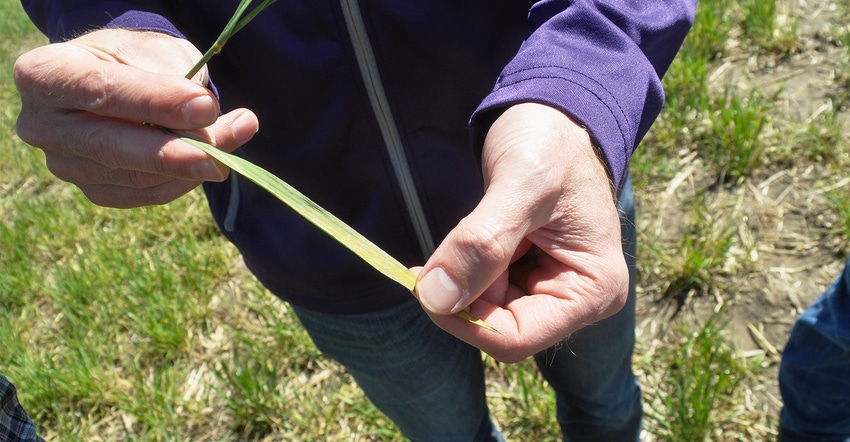
In a modern-day demonstration of the old adage that every cloud has its silver lining, Monsanto WestBred wheat breeder Sid Perry says he has learned a lot while watching the development, progress and harvest of the 2017 winter wheat crop.
Perry says this year’s outbreak of wheat streak mosaic is the worst he has seen in 32 years of breeding wheat for the central and southern Plains.
“As far as both the severity and the scope of infection, this has just been horrific,” he says. “We’ve seen infestation from south of Dallas all the way to Pierre, S.D. In Kansas, I drove from Leoti south for two hours and didn’t see one really decent, unaffected field. It’s a disaster.”
Disaster, however, can be a scientist’s best friend. It provides a wide range of real-world samples of the infectious agents, as well as a chance to study which plants best stand up to the pressure.
“This year was a great opportunity for breeders to get good field screening. We do some greenhouse screening and some work with university researchers, but nothing provides data like a field with uniform infection. It gives us a really clear idea of how things we have in the pipeline will perform and a chance to learn if we have something that won’t do so well in this kind of infection,” he says.
As in any major infection outbreak, this year brought some surprises to Perry. The WestBred variety, Winterhawk, for example, stood up well to the WSMV outbreak, even though it does not have a resistance gene. So did WB4458. However, the variety that was expected to do well, WB4721, didn’t fare as well.
“I have no idea why Winterhawk held up,” Perry says. “I am guessing it has some level of the non-preference trait that we have seen elsewhere. There are just some varieties that the mites don’t particularly like and will move into slower or not at all if they can find plenty of preferred feed.”
He says the secret for WB4458 may lie in its venerable Jagger parentage.
“I remember when Rollie Sears first released that variety at K-State, and I said at the time that this is a variety that will have impact for years. That proved to be right. All these years later, Jagger parentage is still in some of the best-performing varieties out there.”
Jagger was released 23 years ago in 1994 and in its heyday was planted on almost every acre in south-central Kansas. It has been a favorite variety all across Kansas and in 12 other countries. It is in the parent line of the newest K-State releases, including Everest (currently No. 1 in Kansas), the white wheat variety Joe and the 2016 release Tatanka — as well as, obviously, WB4458.
Perry says it was disappointing that a variety expected to hold up to WSMV, WB4721, did not fare well in this year’s heavy infection of the virus.
Perry says he knows of nothing in the chemical pipeline that might help farmers cope with WSMV. Controlling the mites that vector the disease is a problem yet to be solved as any effective control has proved elusive. There are no remedies to help stop the progress of the virus or help plants recover.
He says that the known existence of “non-preference” varieties might lead to an answer. Being able to strengthen that trait to the point that the mites would shun that variety would be the “holy grail” for scientists struggling to come up with a control of the deadly virus.
Perry says he applauds this summer’s education and public awareness campaign about the relationship between volunteer wheat, which provides the feed source, and environment that allows the wheat curl mite to thrive, and outbreaks of wheat streak mosaic virus.
“I think we backed off a bit on education when we had several years without a serious problem,” he says. “This year was a real wake-up call with both the severity of the problem and the widespread area of infection. For years, we have had just a little pocket here or there. We have a new generation of producers that maybe haven’t seen how bad this could be until this year.”
About the Author(s)
You May Also Like




